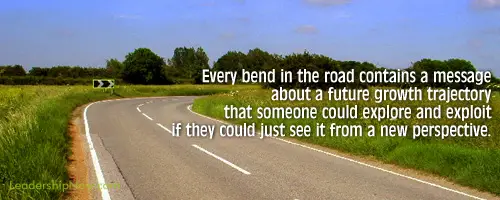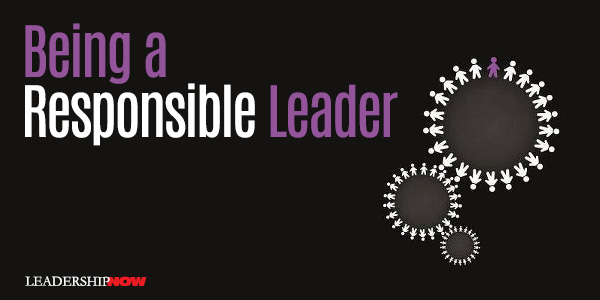 Leading Blog | Posts by Month |
 Leading Blog | Posts by Month |
03.31.15

LeadershipNow 140: March 2015 Compilation
See more on
Posted by Michael McKinney at 08:38 AM
03.27.15

Getting the Attacker’s Advantage
TO Ram Charan, The Attacker’s Advantage is the ability to detect ahead of others those forces that are radically reshaping your marketplace, then position your business to make the next move first. The key is not fearing uncertainty but immersing ourselves in it. It is in the uncertainty that we find the possibilities we can combine to create something new and immensely valuable. We miss the possibilities says Charan because we’re flying at low altitude—immersed in the daily minutia. The other problem is that we gravitate towards being comfortable. Uncomfortable and uncertainty is where the growth is. Uncomfortable and uncertainty is where possibility exists. What we are facing is structural uncertainties or uncertainties arising from our external environment. Charan says the opportunity in structural uncertainty was summed up for him by G. M. Rao, who said, “Every bend in the road contains a message about a future growth trajectory that someone could explore and exploit if he or she looked at it through a different lens without being controlled by an existing core competency.” A world in flux “creates new possibilities and lowers the entry barriers.” Seeing what is happening requires that we develop sharp perceptual acuity. It is seeing in all of the noise the anomaly, the contradiction, the oddity. The more you start looking for these things in your own industry, but perhaps more importantly, in unrelated industries, the better you will get at it. Talk about what you see with others, ask questions, seek contrary viewpoints, ask what’s new daily, watch the social scene and read voraciously, are all ways to help you develop perceptual acuity. Charan notes that “seizing the attacker’s advantage is not the same thing as seeking new ways to use your core competencies.” Attachment to your core competencies interferes with your ability to see clearly and make the right choices. Uncertainly will that we look for ways to grow and expand our competencies—not merely tweak our old ones. “Trying to ignore uncertainty only increases fear, triggering a variety of symptoms, from withdrawal or losing control of your temper to suppressing bad news and blaming others.” Dean Stamoulis commented that “blaming and rationalizing is an extreme red flag….Blaming indicates a thinking style that is not effective in uncertainty, and it erodes the connection with whatever constituencies are taking the heat.” The more you embrace uncertainty the more you’ll be energized by it.  
Posted by Michael McKinney at 05:28 PM
03.10.15

Being a Responsible Leader
THERE has always been a call for responsible leaders, but perhaps we just hear the call more clearly today. In The Responsible Leader, author Tim Richardson begins with a well-written overview of how we got where we are in our leadership understanding and the forces that are shaping our leadership context today. It points to the need for more responsible leadership.What is at the core of being a responsible leader? What are the mindsets the shape the behavior of a responsible leader? Richardson identifies four characteristics: Internal Assuredness and Attractiveness These leaders are confident but humble and their being—who they are—is attractive to others in the sense that they have a natural presence that engages with others and appeals to others at a deeper emotional level. “This is built on a real understanding and acceptance of one’s uniqueness—personality, motivations, strengths and weaknesses—and a confidence that means ‘I do not need to pretend to be someone I am not.’” This is also demonstrated in consistent behavior. “A clear and established values and belief system also helps to smooth out irrational swings of behavior.” “Modern leaders need to be wiser than simply being caught up in the moment.” Adaptability and Learning Orientation We must be comfortable with not knowing and living with paradoxes. This means we must have a willingness to listen and learn—even from the mostly unlikely sources. Once we “know” something we tend to want to hear only from people like us—people who filter the world through the same eyes we do. And when we do, we miss a lot. “We become judgmental and evaluative rather than inquisitive.” We also need to be confident and humble. When an inner confidence “is not balance with sober self-assessment or mature emotional intelligence, it becomes skewed and egocentric.” This is more than intellectual learning, this is behavioral learning. We need to be able to connect what we (and others) are experiencing and connect it to what we know. When it doesn’t connect we need to dig deeper and learn from it. Unfortunately, “individuals may deny that the situation is any different and fail to notice that their normal patterns are proving unhelpful. They may succumb to a personal blindspot and fail to learn.” Thinking and Operating Relationally This is a major shift for most leaders. We tend to grow up thinking of leaders as independent of instead of interdependent with other people. More autocratic than co-creators. Responsible leaders view themselves in relation to others. “Those whose perspective of success relies on others’ success are becoming a stronger force than perhaps many realize.” Purpose and Focus Responsible leaders have a guiding purpose that enables them to focus their energy and activity. “Leaders with a strong driving purpose—that answers the ‘why am I doing this?’ question—need commensurate levels of focus to ensure that their dreams and visions do not remain out of reach. The question is: “Where do I need to focus my attention and my energy and therefore what are distractions to be avoided?” Responsible leadership requires an “other” focus, humility and awareness. “To be a responsible leader is to step forward into the space and the moment with an ‘I can and I will’ mindset to impact situations and systems for the greater good.” 
Posted by Michael McKinney at 12:16 PM
03.09.15

How to Build ROPE Teams in Sales Organizations Neil Armstrong’s historic step onto the lunar surface was not his achievement alone, but the result of decades of effort by a team of thousands. In this, as in most complex human endeavors, teams outperform individuals. Teams have also played a central role in my life by ensuring that I received the support needed to achieve two cherished goals: leading sales organizations at several of the nation’s largest technology firms and climbing the Seven Summits, the highest peaks on each of the seven continents. Along the way, I learned a great deal about team development and leadership. I saw that successful leaders compensate for their personal shortcomings by recruiting team members with complementary skills and temperaments. I observed how they motivated and inspired their teams to achieve something ambitious and meaningful. And then I put those lessons to work in my own business and climbing careers. One of the most critical lessons I learned from climbing mountains and the corporate ladder is that every member of a well-constructed sales team should have a specific role, skillset, and set of responsibilities that aligns with the exigencies of the business being pursued. Equally important, each member should meet the essential “ROPE” criteria I developed over decades of climbing. In other words, they should be: • Reliable and Responsible • Opportunity-driven and Organized • Professional and Practical • Enthusiastic and Expert Inside ROPE Teams As a sales leader, I was responsible for assembling both “Inside” and “Outside” ROPE teams. Our Inside ROPE teams were comprised of colleagues in our company’s marketing, accounting, finance, engineering, support, purchasing, and other functional units. I knew I would need their cooperation and support in order to successfully orchestrate a complex, months-long sales campaign. Inside ROPE teams provide another important benefit. In most companies today, employees are under constant pressure to do more with less. They may feel overburdened and resistant to shouldering new responsibilities. But the members of your team will be much more likely to go the extra mile if you demonstrate a sincere commitment to helping them succeed in their own careers. Once motivated in this way, your Inside ROPE team members will become invaluable assets in helping you to compete successfully for the scarce company resources you’ll need to bring a long and arduous sales campaign to a successful conclusion. Outside ROPE Teams Outside ROPE teams are equally essential to the success of any campaign. To recruit these team members, you’ll want to reach outside your company to forge mutually-beneficial relationships with industry experts, business executives, and other community leaders who can help you expand your industry knowledge, stay abreast of emerging business and technology trends, and secure personal referrals to new prospects. Your Outside ROPE team will play an essential role in helping you find and close business. Keep in mind that Inside and Outside ROPE teams cannot be assembled instantaneously. They must be cultivated over time, using the same strategies you apply to nurture new client relationships. First, you’ll need to identify the most viable prospects, learn what motivates them, and help them become successful. Then, you’ll have to set specific team-building goals and track your progress. Generally speaking, it’s easier to recruit Inside ROPE team members since you’ll be drawing from a limited pool of fellow employees and will have more opportunities for face-to-face interactions. However, you can create ongoing opportunities to build your Outside ROPE teams by networking with members of your local civic or business communities. Kemper Freeman, CEO of Kemper Development Corporation, for example, has been an active member of the Rotary Club for decades. Finally, as a leader, it will be your responsibility to ensure that your relationship with every member of your Inside and Outside ROPE teams is positive and mutually beneficial. After completing a successful sales campaign, for example, I made sure to inform our executive leadership team about the contributions each of our Inside ROPE team members made to our collective success. I was also careful to fulfill every commitment I made to members of our Outside ROPE teams and to proactively pursue opportunities to help them achieve their personal and professional goals. By effectively leading your Inside and Outside ROPE teams, you will build enduring communities that will sustain you throughout your career. Kemper Freeman said it best: “My entire life, I’ve lived by the principle that building a community is one of life’s greatest rewards. To me, building a community means working together, understanding each other, and creating opportunities that are mutually beneficial for everyone.” Susan Ershler is co-author of Conquering the Seven Summits of Sales: From Everest to Every Business, which illustrates the principles that lead to high achievement with anecdotes drawn from her sales and climbing careers. In 2002, she and her husband, Phil, became the first couple in history to climb the Seven Summits—the highest mountain on each of the world's seven continents. Today, Susan is a renowned keynote speaker, inspiring business professionals to push past perceived boundaries to achieve their most ambitious dreams and helping Fortune 500 companies transform their sales organizations into dynamic forces for revenue growth. For more information, visit her web site: Reaching New Heights
Posted by Michael McKinney at 06:14 PM
03.03.15

The 5 Habits of Mind that Self-Made Billionaires Possess
SELF-MADE billionaires think differently than most of us do. Most of us think like what authors John Sviokla and Mitch Cohen call Performers because their success is tracked through performance. They excel at optimizing within known systems. They strive to excel in well-defined areas, and are important to any organization – in fact, they are important to the self-made billionaire. Self-made billionaires have what the authors call the Producer mind-set. They thrive in uncertainty. Producers are critical to any company looking to create massive value because they redefine what’s possible, rather than simply meeting preexisting goals and standards. Combining sound judgment with imaginative vision, Producers think up entirely new products, services, strategies, and business models. For The Self-Made Billionaire Effect, they interviewed 120 billionaires and found that they had in common five habits of mind. What is interesting is that most organizations weed out the very people that they need to create massive value. Imagine what Atari might have achieved if Steve Jobs had stayed there to develop the first mass market personal computer.Self-made billionaires are able to integrate ideas and actions that most individuals and organizations keep separate or even hold in direct tension to one another. Self-made billionaires effectively operate in a world of dualities—they seamlessly hold on to multiple ideas, multiple perspectives, and multiple scales. Here are the five critical dualities that they observed with additional thoughts on each: Empathetic Imagination Producers billion-dollar ideas come through the marriage of extreme empathy for the customer’s needs and wants, and an imaginative mind-set that allows him or her to come up with and explore new, untested ideas. Focusing on the competencies of today is exactly what causes companies to get stuck in the markets they serve and the products they deliver now, with little eye for the shifts and innovation they will need for tomorrow. Sometimes it takes a slight twist in perspective to see opportunities through a different lens. Patient Urgency Producers urgently prepare to seize an opportunity but patiently wait for that opportunity to fully emerge. Producers are willing to operate simultaneously at multiple speeds and time frames. Inventive Execution Producers approach execution of their ideas with the same integrative, inventive mind-set they applied to come up with a billion-dollar idea in the first place. Inventive freedom allows them to design aspects of the customer experience that outsiders consider fixed, thus unlocking new value. Producers frequently operate in markets that require them to rethink the fundamentals of product or business design in order to deliver at scale. Taking a Relative View of Risk Self-made billionaires are not huge risk-takers. Their perceptions of risks are relative: they are far less concerned about losing what they have than of not being part of a bigger future. What Producers are not willing to risk is the chance to capture an opportunity. This dynamic creates a critical duality between the right kind of risk and the resilience needed to do it all over again when the original plan doesn’t work out. Leadership Partnership Producer overwhelmingly do not go it alone. Creating billions in value requires both a master Producer, who can bring together divergent ideas and resources into a blockbuster product design, and a virtuoso Performer, who can apply his or her creative acumen to optimizing the potential of that design. Creating billions in value requires both: the Producer’s ability to bring together divergent ideas and resources into a blockbuster concept and inventive design, and the Performer’s ability to follow through on details needed to make the business work. Why don’t organizations hold on to extraordinarily talented people? These Producers? Here’s the thing: while we can all get behind these attitudes of mind, organizationally we don’t generally reward these traits. We recognize and reward Performers. They get the raises and promotions largely because they're easy to recognize. They fit in; they can hit the ground running. Producers on the other hand don’t always fit because they think differently from those around them. “The ideas they propose move against the standard approach you are following, and that friction is what you need to achieve breakthrough value.” That makes us uncomfortable. As a result, we tend to drive Producers away or cause them to just give up. We need both types, but when looking for new employees we need to look for more people whose background hints at looking at things differently. People who have started something new. People with the raw imagination to see something new and the fortitude necessary to work through the difficulty of execution. “The key imperative for management is to differentiate between opportunities that need a Performer and those that need a Producer. Look at areas of achievement for the business and at who did the work. When it is a Producer, recognize that and give that Producer her next Producer-appropriate challenge.” As leaders we need to accept both Producers and Performers and reject neither. We need to find and support positive deviance while promoting for systematic improvement. 
Posted by Michael McKinney at 11:30 PM
03.01.15

First Look: Leadership Books for March 2015Here's a look at some of the best leadership books to be released in March.




For bulk orders call 1-800-423-8273  Build your leadership library with these specials on over 100 titles. All titles are at least 40% off the list price and are available only in limited quantities. “We read to know we are not alone.” — C.S. Lewis
Posted by Michael McKinney at 06:38 PM
|
BUILD YOUR KNOWLEDGE


How to Do Your Start-Up Right STRAIGHT TALK FOR START-UPS 
Grow Your Leadership Skills NEW AND UPCOMING LEADERSHIP BOOKS 
Leadership Minute BITE-SIZE CONCEPTS YOU CAN CHEW ON 
Classic Leadership Books BOOKS TO READ BEFORE YOU LEAD |
|